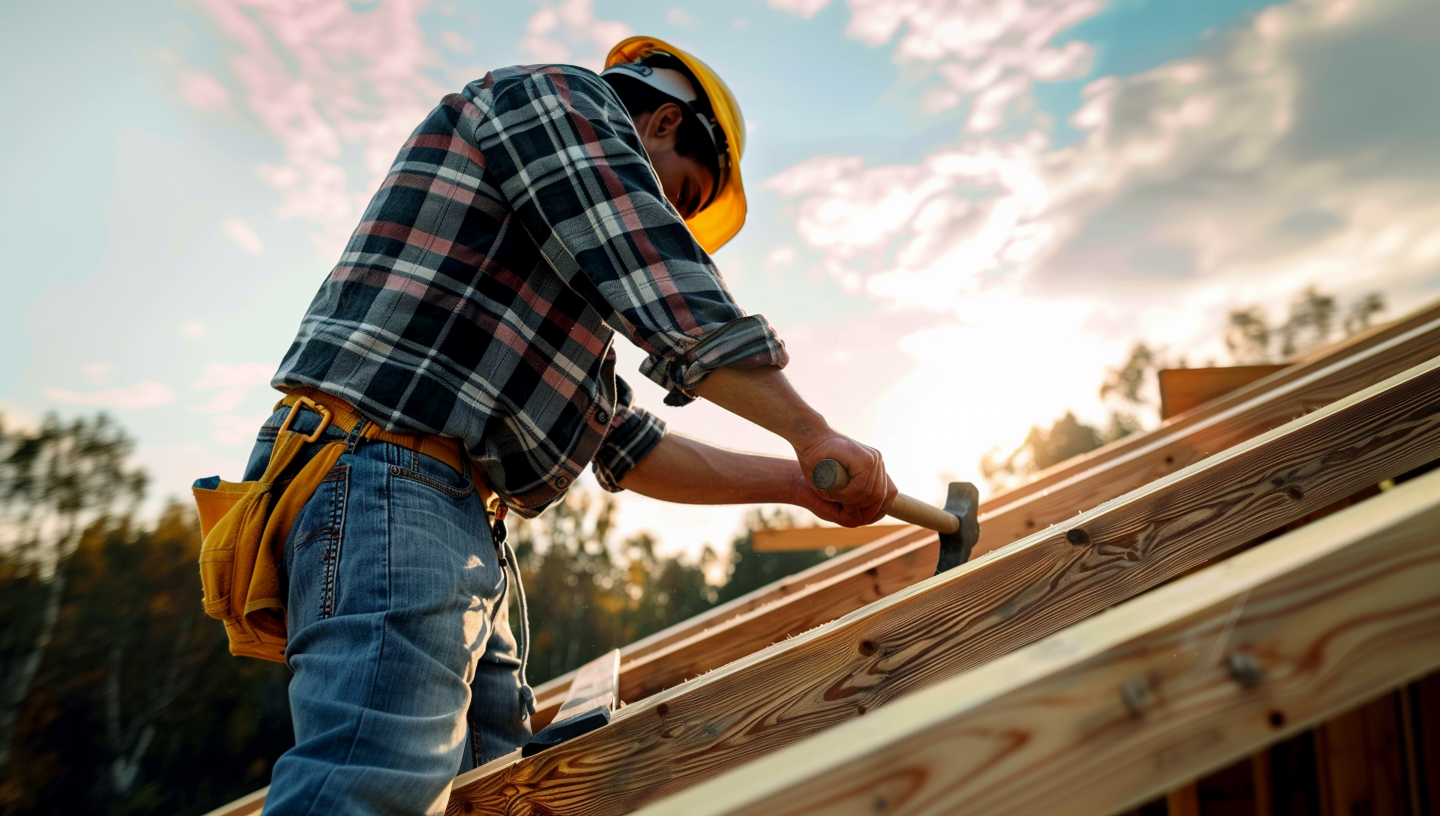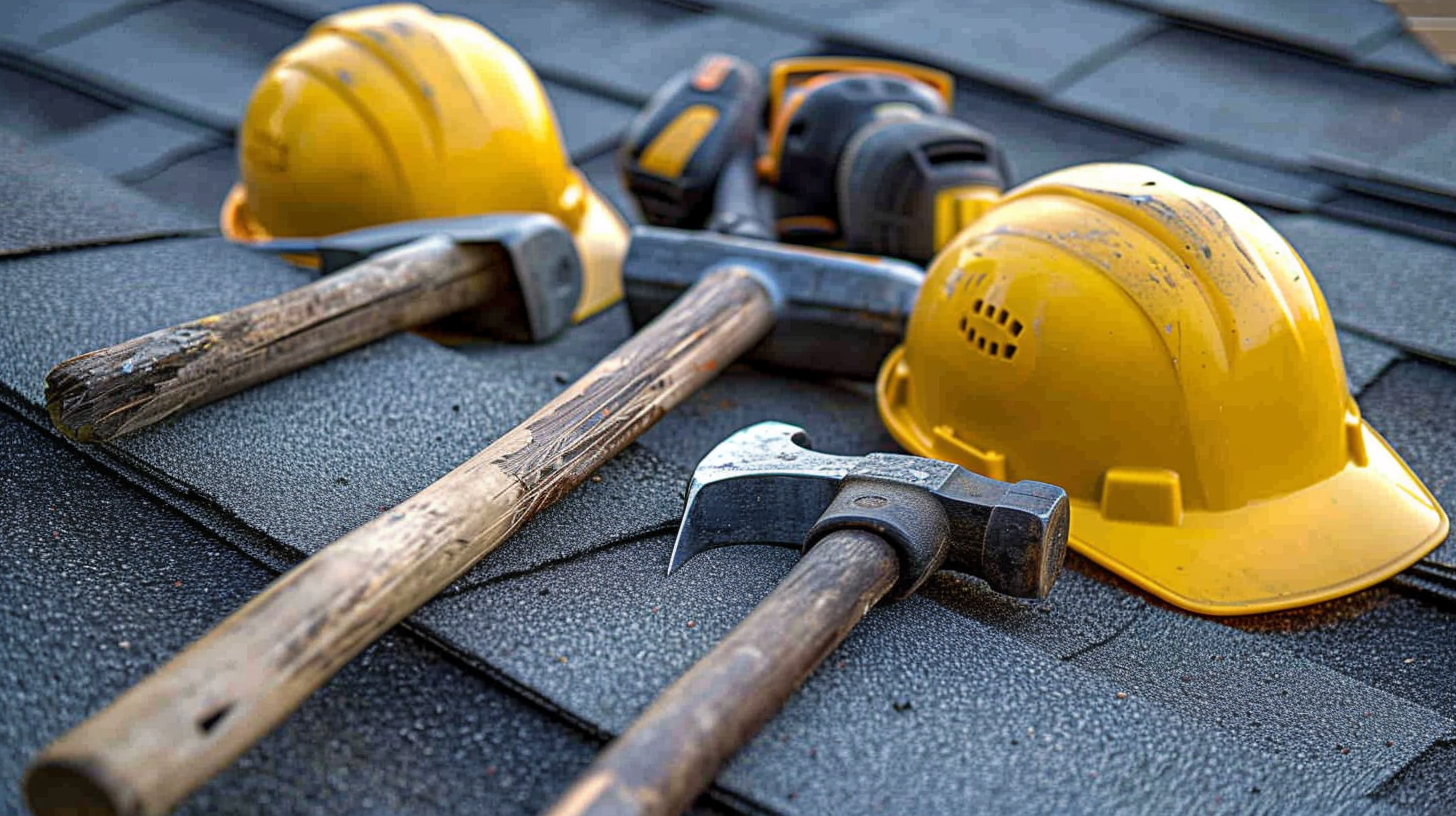Importance of Roofing Hammers

Hammer - History of Roofing Hammers - Sky Roofing Construction & Remodeling
History of Roofing Hammers
Roofing hammers have a rich history dating back to ancient civilizations. In ancient Egypt, for example, workers used wooden mallets to attach clay tiles to roofs. Hammers with stone or metal heads emerged in ancient Greece and Rome. These early roofing hammers were simple yet effective tools that laid the foundation for advancing modern-day roofing hammers. Fast forward to the Middle Ages, and the design of roofing hammers evolved to resemble the claw hammer we are familiar with today. The claw-like feature enabled workers to drive and remove nails efficiently, enhancing the overall roofing process. Over time, materials such as iron and steel replaced wood as the preferred hammerhead choice, making them more durable and practical.
Roofing hammers have become essential tools for roofers, contractors, and DIY enthusiasts. They are specially designed with features such as a serrated face for gripping nails, a claw for effortless nail extraction, and a fiberglass or steel handle for durability and shock absorption. Some modern roofing hammers also incorporate innovative features such as magnetic nail holders or adjustable gauges for consistent nail placement. With advancements in technology and materials, roofing hammers continue to evolve, ensuring that roofing and construction projects are completed with precision and efficiency.

Hammer - Evolution of Roofing Hammers - Sky Roofing Construction & Remodeling
Evolution of Roofing Hammers Over Time
1. Enhanced Design and Functionality: The evolution of roofing hammers has introduced more ergonomic designs, ensuring comfort and ease of use for roofers who spend hours handling these tools. Modern roofing hammers feature improved handle grips, reduced weight, and balanced construction, allowing for better control and maneuverability.
2. Durability and Longevity: Roofing hammers have become more robust and long-lasting with advancements in materials and manufacturing techniques. Incorporating more robust steel heads and reinforced handles has significantly increased the tool’s durability, making it resistant to the rigorous demands of roofing tasks and prolonged use.
3. Specialized Features: The evolution of roofing hammers has introduced specialized features to enhance functionality. Some models now include magnetic nail holders, allowing for one-handed operation and reducing the risk of dropped or lost nails. Others feature claw side pullers, which aid in extracting nails and reducing damage to roofing materials.
4. Versatility and Adaptability: Modern roofing hammers are designed to cater to various roofing materials and styles. The diverse range of hammerheads and claw designs enables roofers to work efficiently with different materials, such as shingles, tiles, and metal roofing. This adaptability improves productivity and ensures compatibility with many roofing projects.

Hammer - Traditional Materials Used - Sky Roofing Construction & Remodeling
Traditional Materials Used for Roofing Hammers
Steel is one of the most famous traditional materials used in roofing hammers due to its exceptional strength and resistance to wear and tear. Known for its durability, steel hammers can withstand heavy use and repetitive pounding, making them perfect for roofing applications. The weight of steel hammers provides better control and balance, enabling precise nail driving and reducing the effort required by the worker. Steel roofing hammers have become a staple in the industry with their long lifespan and reliability.
Fiberglass is another commonly used traditional material for roofing hammers. These hammers feature a fiberglass handle that offers several advantages over other materials. Fiberglass handles are lightweight yet incredibly strong, reducing strain on the user’s arm and shoulder while providing excellent shock absorption properties. This material is also non-conductive, making it safer to use during electrical projects or in areas with potential live wires. Additionally, fiberglass handles are resistant to weathering and do not shrink or splinter, ensuring the longevity and reliability of the roofing hammers.
Types of Roofing Hammers
1. Claw Hammer: The claw hammer is a versatile and widely used tool in various construction projects, including roofing. With a flat, striking face on one side and a curved claw for nail removal on the other, it can be used effectively for roofing tasks, such as driving nails, removing existing roofing materials, and prying apart components. Its multi-functionality and availability make it a popular choice among roofers.
2. Roofing Hatchet: The roofing hatchet is a specialized hammer designed explicitly for roofing tasks. It features a striking face on one side and a hatchet blade on the other, allowing for efficient cutting and trimming of roofing materials, such as shingles. The hatchet blade is typically beveled for precision cutting, enhancing its effectiveness for roofing jobs.
3. Square Head Hammer: The square head hammer is commonly used in roofing projects. It features a square striking face and a flat face opposite to it. The square face ensures a secure and precise connection when driving nails into roofing materials, reducing the risk of slippage or damage. Its flat face can be used for flattening or adjusting nails during roofing.
Magnetic Roofing Hammer
Modern roofing hammers also have additional functionalities. Many of these hammers have built-in nail holders, so roofers don’t have to carry a separate nail pouch, further enhancing their convenience and efficiency. Moreover, these hammers are crafted with shock-reduction materials, reducing fatigue and strain on the user’s hand during prolonged use.
Another notable feature is the shingle removal tool integrated into the hammer, which allows for easy removal of damaged or old shingles. This adds to the tool’s versatility and makes it a practical choice for roofing projects.
Lastly, some roofing hammers include metric gauges for more extensive shingle exposures, catering to different roofing needs and ensuring measurement accuracy. With these additional functionalities, a magnetic roofing hammer becomes an indispensable tool for roofing professionals, offering efficiency, convenience, and durability.
Features and Benefits of Using a Magnetic Roofing Hammer
Versatility: One of the critical features of a magnetic roofing hammer is its versatility. A built-in magnetic head lets roofers quickly pick up and hold nails, reducing the risk of dropping or losing them. This feature helps speed up the roofing process and eliminates the need to bend down or search for misplaced nails constantly.
Efficiency: The magnetic roofing hammer reduces the time and effort required to complete roofing tasks. It securely holds nails, enabling roofers to drive them into the roof quickly and accurately, ensuring a secure and stable installation.
Improved Safety: A roofing hammer’s magnetic feature significantly improves safety by minimizing the risk of nails falling or becoming a potential hazard on the job site. This prevents accidents and injuries caused by stepped-on or misplaced nails, promoting a safer work environment.
Durability: Many magnetic roofing hammers are constructed using high-quality materials, making them highly durable and long-lasting. This ensures they can withstand the rigorous demands of roofing and construction work, allowing professionals to rely on them for an extended period without needing frequent replacements.
How The Shielded Neodymium Magnet Aids in Efficiency
The shielded neodymium magnet offers immense benefits in terms of efficiency during roofing and construction work. Firstly, it eliminates the hassle of fumbling for nails or constantly reaching into a tool belt for supplies. By firmly holding nails in place, the magnet allows roofers to maintain a seamless workflow, reducing unnecessary interruptions and time wastage. Additionally, the shielded neodymium magnet aids accuracy by providing a reliable and steady source for holding nails, ensuring they are always within reach. Roofers can quickly grab nails and drive them into the desired spot without pausing and searching for them, resulting in precise and efficient nail placement.
Modern hammers, including the magnetic head roofing hammer, often feature magnetic nail starters that make beginning a nailing task even more efficient. These hammers’ extra grip ensures the user’s grip is secure, minimizing slippage and enhancing control. Roofers using magnetic tack hammers benefit from the magnetic feature as they hold tacks and nails securely, speeding up the process of securing laminate shingles.
In the roofing industry, inventory levels of various hammers, such as solid-head hammers, fiberglass hammers, and sled hammers, are crucial to meet the diverse needs of projects. Some heavier hammers can be cumbersome while offering more driving force, making the lightest hammers a preferred choice for many tasks. The single-piece design of many modern hammers contributes to their durability and reliability.
Whether using a soft hammer for delicate tasks or a nail hammer for more robust applications, the perfect hammer enhances overall efficiency. The hammer strike, aided by features like the shielded neodymium magnet, ensures accurate nail placement, reducing errors and rework. Incorporating these features in modern roofing tools significantly aids in the precision and speed of project completion.
Shingling Hatchet
Purpose and Design of A Shingling Hatchet
A shingling hatchet, also known as a roofing hatchet, is designed explicitly for shingling tasks in the roofing and construction industry. Its primary purpose is to assist in installing or removing shingles, ensuring a secure and durable roofing system. With its sharp and durable blade, a shingling hatchet allows roofing professionals to cut through shingles precisely, providing a clean and efficient process. Additionally, the shingling hatchet’s claw end is instrumental in removing old or damaged shingles, enabling seamless repairs and replacements.
The design of a shingling hatchet is tailored to optimize its functionality and ease of use. Typically, it features a robust and solid steel construction to withstand heavy-duty tasks and ensure longevity. The head of the hatchet consists of a sharp edge, beveled for exceptional cutting performance, and a claw end that assists in shingle removal. The handle is often made of durable materials such as wood or fiberglass and shaped for a comfortable grip, enabling efficient and precise control while working. A shingling hatchet’s compact and lightweight design contributes to its portability and maneuverability on rooftops.
Comparison to Other Types of Roofing Hammers
When comparing the roofing hammer to other types of hammers, such as a framing hammer or a claw hammer, it excels in its specialized features tailored for roofing and construction purposes. Unlike a framing hammer, designed for general carpentry work, the roofing hammer features a shorter, slimmer handle for a better grip on overhead surfaces. The roofing hammer’s head is also designed with a flat face for striking nails precisely and a dedicated hatchet edge for quickly removing old roofing materials. Unlike a claw hammer with a curved claw for nail removal, the roofing hammer’s hatchet edge allows for more efficient and effortless removal of roofing materials.
Ounce Roofing Hatchet
Benefits of Using an Ounce Roofing Hatchet
How it Differs From Other Hatchets in Terms of Weight and Grip
The roofing hammer sets itself apart from other hatchets with its lightweight design. This feature is crucial for roofers who must handle the tool for extended periods. The reduced weight of the roofing hammer allows for increased maneuverability and less strain on the user’s arm, minimizing fatigue and improving overall productivity. The balanced weight distribution of the hammer also contributes to its ease of use, providing roofers with better accuracy and control during hammering tasks.
Additionally, the roofing hammer often incorporates features like a nail claw, making it more versatile for various roofing tasks. Tools such as hammer tackers and shingle hammers also play a significant role in roofing projects, each designed to enhance efficiency.
Another area where the roofing hammer distinguishes itself is in its grip. The handle is designed to provide comfort and enhance the user’s grip. The ergonomic handle shape and texture offer a secure hold, reducing the likelihood of the hammer slipping during use. This added grip significantly improves safety and efficiency in roofing tasks, allowing roofers to work confidently and effectively, even in challenging conditions or at different angles.
Many roofing hammers, including those with patent-pending designs, ensure that roofers have the latest advancements in tool technology, further distinguishing them from other hatchets in the market.
Key Features to Consider When Choosing a Roofing Hammer
1. Durability: The durability of a roofing hammer is crucial as it determines its longevity and ability to withstand the demanding conditions of roofing work. Look for hammers made from durable materials such as steel or fiberglass, ensuring they can withstand repeated use and challenging roofing environments.
2. Weight: The weight of the roofing hammer directly affects its maneuverability and ease of use. Opting for a hammer with a comfortable weight allows roofers to work for more extended periods without experiencing fatigue. Consider hammers with a balanced design and ergonomic handle to reduce strain on the user.
3. Handle Material: The choice of handle material dramatically influences the hammer’s grip and impact absorption. Wooden handles offer a traditional, comfortable grip, while fiberglass handles enhance strength and shock absorption. Choose a handle material that suits your preference and comfort levels.
4. Claw Design: A roofing hammer’s claw is essential for efficiently removing old nails and materials. Look for hammers with V-shaped or straight claw designs, as they provide better traction and leverage for easy nail extraction during roof repairs or replacements.
5. Versatility: Some roofing hammers have additional features, such as magnetic nail holders or built-in nail removers, enhancing their versatility and convenience. Consider these additional functionalities to streamline your roofing tasks.
Get the Best Results with the Right Roofing Hammer
If you’re in need of a reliable hammer for your roofing projects, Sky Roofing Construction & Remodeling is here to help (https://skyroofingconstructiontx.com). Our team understands the importance of having the perfect hammer for every task, ensuring efficiency and precision. Contact us today at (210) 942-9797 to schedule your roofing installation and experience the difference professional tools and expertise can make.
Arthur McCain is a dedicated contributor to Sky Roofing Construction & Remodeling, focusing on the latest roofing materials and innovative construction techniques. With a background in architectural design, Arthur brings a deep understanding of how modern materials can enhance both the durability and aesthetic appeal of roofing projects. His articles offer readers cutting-edge insights into selecting the best materials for their homes.

